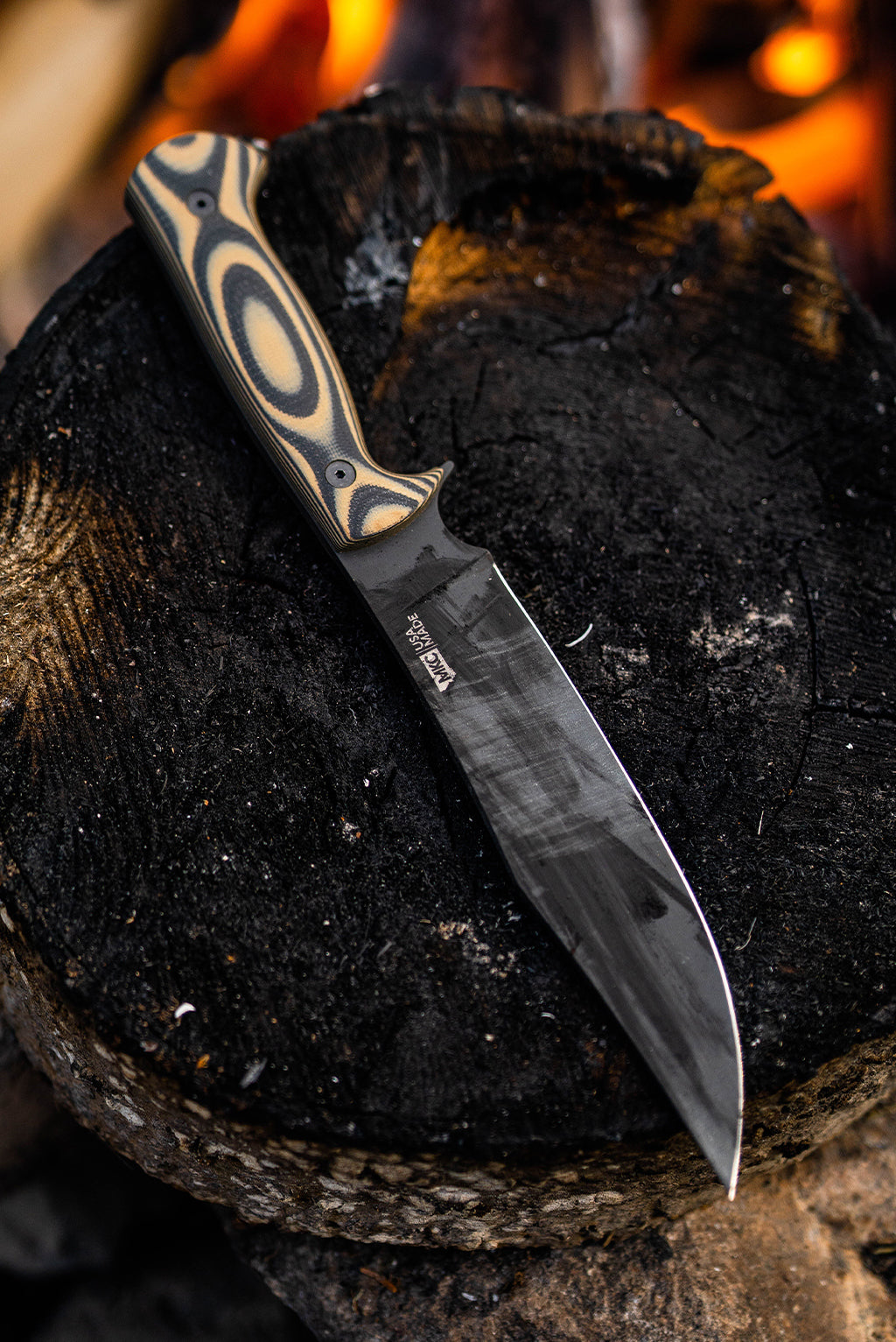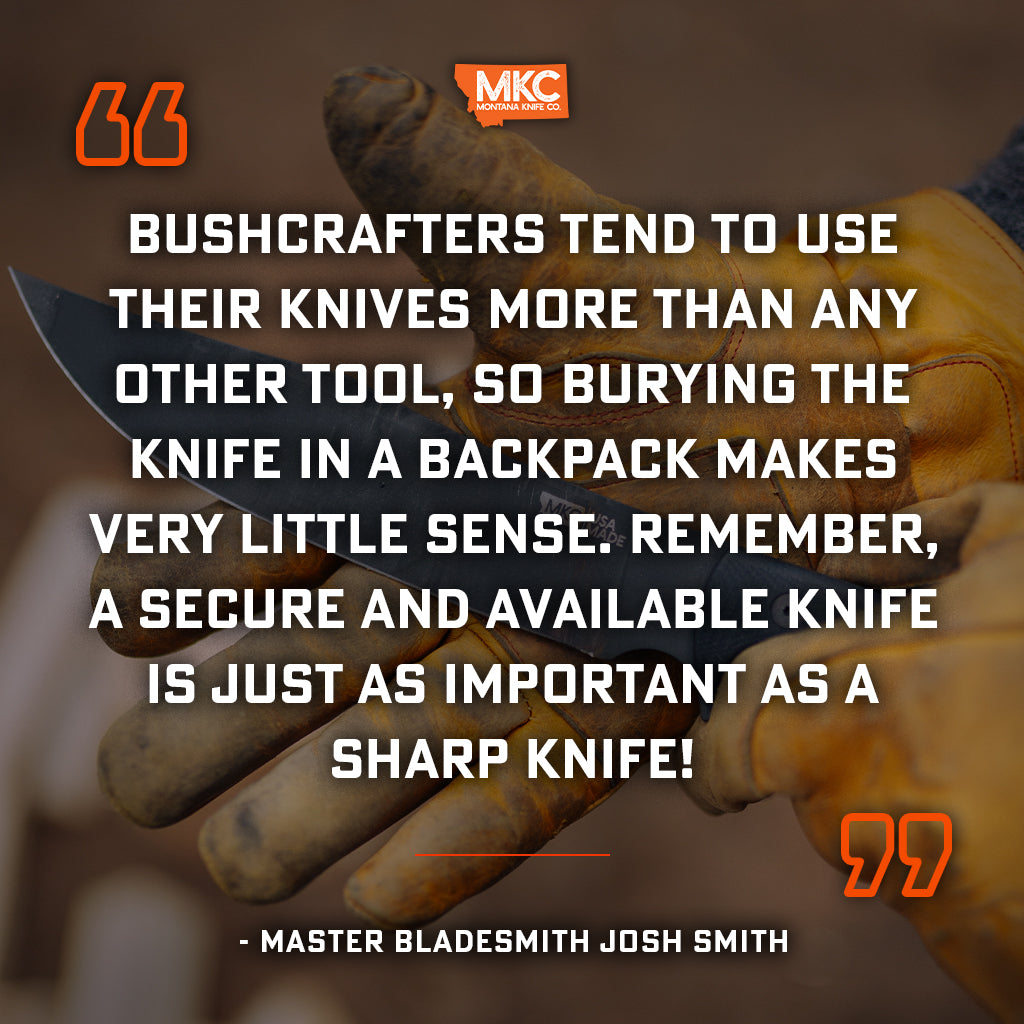Most bushcraft knives, or survival knives, are carried in cases by people on backcountry hikes or engaged in survival exercises. In other words, they’re stored away and taken out for special purposes.
But any knife can become a “survival” knife depending on the circumstance. Driving your car to town can turn into a survival situation. Going out for a day hunt only a mile from your truck can turn into a survival situation. The list goes on.
Ultimately, nobody plans to find themself in a survival situation, but any scenario can turn into a test of survival when things go wrong. That’s why we make all our blades to be strong and versatile enough to be used for self-preservation and self-defense.
It’s also why our particular style of survival knife isn’t called a “survival knife.” I see it as more of a bushcraft knife, designed for someone who is going out to intentionally practice the art of bushcraft. Maybe you’re going out as a weekend warrior, expecting to build your own shelter, forage for food, or reenact something you watched on a show like “Alone” or “Naked and Afraid.”
These are all reasons to carry an actual bushcraft survival knife over a regular hunting knife. But in a world with no shortage of options, how do you choose the best bushcraft knife?
How to Choose the Best Bushcraft Knife
Ideal Size for Bushcraft Knife Design
First and foremost, a bushcraft survival knife should have some size to it. You might find yourself in a situation where you have to chop wood or take down a small tree to build a shelter. You’ll want a knife with enough heft to handle that kind of abuse.
But size comes with added weight, which can be a problem when you’re carrying a lot of gear. Finding that perfect balance between size and weight is a game we hunters play every time we choose a knife, even a simple pocket knife we pick up at the store!
But generally, a bushcraft survival knife should be at least six inches in length, but no longer than eight inches.
Ideal Blade for Bushcraft Knife Design
The ideal bushcraft survival knife blade should be thick and durable enough to withstand the abuse of chopping through wood or even ice.
In some cases, a blade will need to be used as a pry bar or shovel. The best bushcraft knife will have a robust last half inch of blade so it can do that kind of work.
The spine should also be thick enough to handle the exertion of prying. For this purpose, it’s more important that the blade steel be functional than thin. Edge retention is less important here than blade toughness. You don’t want your blade to be so fragile that it chips under stress.
Of course, there are trade-offs when it comes to weight — the thicker and sturdier the blade, the heavier the weight, and the more difficult the knife is to carry.

Best Handle for Bushcraft Knife Design
The handle is one of the most crucial elements of a bushcraft survival knife.
The best bushcraft knife handle will be comfortable, especially during prolonged use, like chopping. If the handle is too round, the blade will want to turn in the hand when it’s striking something hard or at an angle.
The tighter you have to grip the handle, the more fatigued your hand will become from trying to hold the blade steady. Look for a handle with flat sides that orient that blade correctly and require less grip strength over long periods of use.
Also, pay attention to the angle at which the blade comes out of the handle. The blade should be centered and aligned with the handle, which then aligns with your hand and arm, ensuring good control and leverage.
You also need a way to keep your hand from slipping up on the blade. Handles should have some sort of guard system that keeps your hand in place, even if you’re fatigued or cold and wet. Likewise, when you’re chopping wood, your hand shouldn’t ride up on the blade.
A bushcraft handle should also attach to a lanyard or paracord that ties to your arm while you’re working. This ensures that if you do lose your grip, your knife won’t become a flying object that can hurt someone in your vicinity.
That being said, I don’t suggest openly carrying a bushcraft blade by a lanyard. It’s better to untie the lanyard or wrap it around the handle like we do with the Speedgoat. If you carry it with an open loop as you move through wilderness, there’s a chance the blade will get caught on something, get ripped out of its sheath, and potentially get lost or cause injury.
Best Carry System or Sheath for a Bushcraft Knife
I find this is the feature people think about the least when it comes to survival knives — or any kind of knife. The ability to carry a knife safely and securely in an accessible way is extremely important in all situations.
Bushcrafters tend to use their knives more than any other tool, so burying the knife in a backpack makes very little sense. Remember, a secure and available knife is just as important as a sharp knife!
Spine and Ferro Rod in Bushcraft Knife Design
Any bushcraft survival knife needs a sharp spine on the blade that can throw a spark off a ferro rod.
MKC sheaths are designed with holes for mounting accessories like ferro rods, which certainly come in handy in survival situations.
Best Bushcraft Knife Design: Final Thoughts
The best bushcraft knives have durable blades with good edge geometry and a robust point. They have a handle that’s comfortable, secure, and durable, and they have a secure and accessible sheath or carry system.
Bear this in mind the next time you go in search of a bushcraft knife, and I guarantee you’ll forget all your previous knife troubles!
by Josh Smith, Master Bladesmith and Founder of Montana Knife Company












































![Air gun 101: The differences between .177 & .22 – Which jobs they do best ? [Infographic]](https://airgunmaniac.com/wp-content/uploads/2020/09/g44-150x150.jpg)